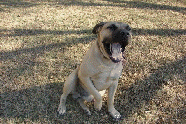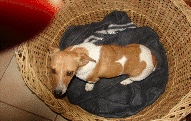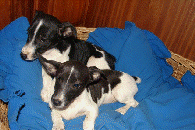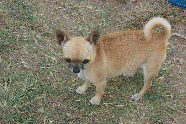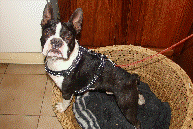Dog Breeds A - M








The Chihuahua is the smallest of the toy dog breeds. This breed has a rounded head with large erect ears and a short tapered muzzle. Chihuahuas weigh from 2 to 6 pounds and stand from 5 to 9 inches tall at shoulder height. There are two varieties of Chihuahuas – Smooth-coat and Long-coat. Both varieties of the breed are similar except for their coats. Smooth-coated Chihuahuas are the most popular and have glossy, smooth and soft coats where the fur lies close to the body. Long-Coated Chihuahuas have longer soft coats with feathering on tail, ears, neck and feet. All coat colours are permitted for both varieties of Chihuahuas.
Chihuahuas are intelligent, charming and loving dogs who are devoted to their owners. This breed needs close contact with its family and make great companions. Chihuahuas can have delusions of grandeur and self-confidence and will challenge much larger dogs. These tiny dogs have to be watched carefully or they could be severely injured in a fight. Chihuahuas are good with older children if raised with them. However the breed is too small to be a toddler’s pet. Chihuahuas are intelligent and can be trained fairly easily. However this breed can be difficult to housetrain, especially in winter. An indoor cat littler box might be a good solution to winter housetraining. Some Chihuahuas can be overly insecure and early socialization while a puppy is recommended. Chihuahuas make good watchdogs although their excessive barking can be annoying.
Chihuahuas are the ultimate apartment dog and usually get enough indoor activity that they don’t need any regular exercise. If you do take this breed outside for a walk, they may require a warm jacket in winter. Try not to let this breed jump off furniture as they can injure themselves.
Smooth-coated Chihuahuas need occasional grooming with a rubber brush. Long-coated Chihuahuas need regular brushing and trimming. This breed can have a single soft coat with minimal shedding or a double coat with moderate shedding. Check your puppy’s teeth to see that they are coming in correctly and keep checking adult teeth regularly for tartar. Since Chihuahuas don’t get much pavement exercise, remember to keep their claws trimmed.
Chihuahua
Chinese Crested
The Chinese Crested is a lively and graceful member of the toy dog breeds. There are two varieties of Chinese Crested – The Hairless and the Powder Puff. The Hairless Chinese Crested has a fine grained smooth skin that seems warm to the touch. These Chinese Hairless have a crest of hair on their heads, tufted feet and plumed tails. The Powder Puff Chinese Crested has a soft silky and abundant coat. All colours and colour combinations are allowed for both varieties of Chinese Crested. This breed is approximately 9 to 13 inches tall at shoulder height and generally weighs less than 13 pounds.
The Crested is a happy and animated dog that needs a lot of personal interaction with its owner. These agile dogs are very good climbers and jumpers and can even grip objects and toys with their paws. The breed loves its owner and family and gets along well with older children and other pets. The Cresteds are very active and inquisitive indoors and need early training while puppies to control these activities. This breed is intelligent and fairly easy to train except when it comes to housetraining. Housetraining can be very difficult and a cat litter box might be considered in winter weather. The Chinese Cresteds make ideal companions for elderly apartment dwellers that can’t get out to exercise their dogs. Cresteds are suspicious of strangers and make good watchdogs.
The Crested gets sufficient exercise chasing a ball indoors in inclement weather but does enjoy a romp outside in a safe enclosed area. Cresteds need sweaters in the winter when they go outside. In the summer this toy breed needs a T-shirt to prevent sunburn.
The Chinese Hairless needs regular baths, moisturizers and even sun block. This toy’s skin should be kept supple and smooth and prevented from drying out. The Chinese Powder Puff needs regular brushing, trimming and bathing. The Cresteds sweat through glands in their feet and skin so daily sponge and weekly baths are recommended. This breed is a very light shedding dog if properly groomed and is often referred to as ‘hypoallergenic’.

The Boston Terrier is a delightful little dog which despite its name is not one of the terrier dog breeds. Boston Terriers are one of the most popular breeds in the United States because they are easy to look after and very affectionate dogs. This breed is compact, muscular and is distinguished by a square and flat-topped head with a very short muzzle and deep jowls. The Boston’s coat is composed of short and fine hair that is shiny in appearance. This breed’s color is usually brindle with white markings or sometimes black with white markings. Boston Terriers range from 10 to 16 inches at shoulder height and can come in three weight classes: lightweight is under 15 pounds; middleweight is 15 to 20 pounds; and heavyweight is 20 to 25 pounds.
Bostons are affectionate and lively house pets and good companions. This breed is very intelligent and loves to learn new tricks. Early socialization and obedience training will ensure this dog will develop good manners. These dogs seem to do especially well with older people. Most Bostons are good with children and other pets if they have been raised with them. This breed makes good pets for older children who can appreciate their sense of humour and funny antics. Bostons like to learn and are easy to train. These dogs may be somewhat difficult to housetrain. Boston Terriers make good watch dogs without excessive barking.
Boston Terriers can adapt equally well to apartment living or country living but should have daily exercise. Avoid outdoor exercise in very hot or cold weather. Bostons, especially the light weight variety, can be classified as ‘indoor dogs’.
Bostons require minimal grooming. These dogs just need a rub down with a damp towel several times per week. This breed is clean and has little doggy smell. Boston Terriers are very low-shedding dogs and are often referred to as ‘hypoallergenic’.
Boston Terrier
Boxer
The Boxer is a strong and muscular medium-to large-sized dog that is very energetic. Boxers are very popular because they are one of the better dog breeds for families with children. The Boxer’s short, smooth and shiny coat is usually red, fawn or brindle in colour. Some Boxers have white markings on their coat. Boxers stand 21 to 25 inches at shoulder height. Male Boxers can weigh from 65 to 70 pounds while females can weigh from 50 to 65 pounds.
Boxers are good-natured, lively and playful. Boxers love children. However toddlers should be watched with excited adolescent dogs that tend to knock them over. This breed needs long and regular walks to control its exuberance. Boxers are strong and active and need early obedience training and socialization while they are still puppies. Boxers are alert, intelligent and eager to please, so they are suitable for higher-level obedience training. The breed is naturally suspicious of strangers and usually makes a good watchdog. These dogs can also be trained to be good guard dogs.
Boxers need a lot of exercise including off-leash romps with other dogs. Boxers can adapt to apartment living if they are thoroughly exercised twice per day to work off their energy. This breed can be sensitive to heat and shouldn’t be taken jogging or cycling during hot summer days.
Boxers need minimal attention for grooming and are low to moderate shedders.
The Boerboel has been specifically bred as a protector. Their even character and friendly disposition should ensure that they are on top of your list as your next best friend. A well bred Boerboel should always be on your wave length and be ready to act when ever you feel threatened. The dog should also be able to sense when ever you feel uneasy about a specific individual, and he will no doubt make his presence felt in order to provide you with the necessary protection. This protective instinct is obvious even as a puppy. By training your animal to attack, you will find that he is able to growl like a lion and protect you with a ferocity that doesn't take its own safety into account. The Boerboel is a family dog, often spending hours playing with the children and accepting the protection of the whole family as his duty and cares for all of them.
A Boerboel is a loyal and devoted family guardian that loves children especially. They very seldom bark, but when they do you can be sure it is for a good reason. One of the early kennels said of its Boerboels that they were, "faithful, fearless, but not ferocious". This sums up a well-bred Boerboel today just perfectly.
Boerboel
Dachshund
The Dachshund (pronounced DAHKS-hoond and commonly misspelled as Daschund) is a dog breed with a diverse range of characteristics. Dachshunds are small dog breeds with a long body, short crooked legs and large floppy ears. Dachshunds come in two sizes, three varieties of coat, many colors and patterns. The Miniature Dachshund stands about 12 inches tall at shoulder height and should weigh less than 11 pounds. The Standard Dachshund stands more than 14 inches tall at shoulder height and usually weighs between 15 and 30 pounds. The breed comes in three different varieties of coat – Shorthaired (or smooth), Longhaired and Wirehaired. The Shorthaired or Smooth variety is the most common and has a short dense and shiny coat. The Longhaired variety has a soft and sleek coat that is well fringed on the ears, chest, underside of the body, legs and tail. The Longhair looks something like a small Irish Setter. The Wirehaired version has a short, dense, wiry outer coat with dense undercoat. This variety also has a beard, bushy eyebrows and ridges over the eyes. Another area of diversification is the coat color and pattern. The most common colors are red (ranging from reddish blond to a deep rusty red) and a black with tan markings. Other two color combinations are chocolate. blue and fawn with tan markings on the head, chest and paws. Wirehairs quite often have a black and light hair mix called wild boar. The final area of diversification is the pattern on the Dachshunds coat. There is a dapple pattern consisting of lighter areas contrasting with a darker base color and a double dapple pattern which has varying amounts of white as well as the dapple pattern. Finally there is a brindle pattern with dark stripes all over the body.
Dachshunds or Doxies are playful and fun-loving small dogs who are similar to terriers in their inquisitiveness and need to be involved in everything. This breed is very attached to its owner and wants to be with him/her all the time – even in bed. Dachshunds are very adaptable to city life and even apartment life. Miniature and Toy Dachshunds do well in apartments. Standard Dachshunds must have regular walks and lots of companionship and /or other pets. This breed loves to play with other wiener dogs. Doxies are fine with older children but do not like the rough handling they may receive from a toddler. Dachshunds can be independent and stubborn and are difficult to housebreak and train. Socialization and training should be started when they are puppies and enforced through adolescence. Barking should never be rewarded. Training should be food-based and game oriented. Doxies won’t respond to any harsh training methods. The Long-haired variety seems to be more obedient and docile than the other two varieties of Dachshunds. This breed makes an excellent watchdog although they can be too ‘barky’.
Dachshunds need a long and brisk walk every day. Standard Dachshunds can adapt to apartment living but should be walked both morning and evening. Caution must be taken to stop these dogs from jumping off of furniture and hurting their backs. Do not over feed this breed as it will lead to back problems.
Short-haired Dachshunds need minimal grooming, have no ‘doggy odor’ and are light shedders. The Wire-haired and Long-haired Dachshunds will require regular brushing and some trimming and clipping. These dogs are still fairly light shedders and relatively free of ‘doggy odor’.


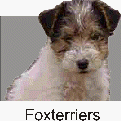

Fox Terrier
There are actually two types of Fox Terrier, the Smooth and the Wire haired, which the American Kennel Club (AKC) classifies as two distinct dog breeds. The Smooth Terrier variety has a short, thick, smooth and waterproof outer coat with a soft undercoat. The Wire Terrier variety has a rough coat that is dense, hard and somewhat curly. The Wire also has longer hair around the eyes, muzzle and feet. Both these Terriers are mainly white with tan and/or black markings. Fox Terriers stand about 15 inches tall at shoulder height and weigh approximately 15 to 20 pounds.
Fox Terriers are probably the liveliest and most energetic of all the terrier breeds. The two varieties, the Wire haired and the Smooth, differ only in coat type. The temperaments of both Terrier breeds are identical. These Terriers are very intelligent, curious, cheerful and love their families. The breed has so much energy that it never runs out of steam. These dogs love to play and will chase a ball or Frisbee for hours on end. Fox Terriers make great playmates for older children but still retain their hunting instincts and shouldn’t be left alone with small pets. These Terriers should be kept on their leashes when being walked. The breed has a stubborn streak and socialisation and training should be started when they are puppies and continued into adulthood. Fox Terriers can be possessive of their food and toys. Terrier owners should be active, firm and confident.
Fox Terriers need a lot of daily exercise so their limitless energy doesn’t drive their family crazy. The breed needs a fenced yard so it won’t escape and chase small prey.
The Wire needs a fair amount of grooming. The Wire’s coat needs to have the dead hair plucked out of its coat several times per year. It also needs twice weekly brushing and combing. The Smooth only needs a weekly brushing with a rubber brush to remove loose and dead hair.

Jack Russell Terrier
(Parson Russell Terrier)
Jack Russells were bred for character and not conformation and as a result they came in a lot of different coat types and leg lengths and were difficult to classify by the various country kennel clubs. The Jack Russell is a small, compact and very athletic dog that comes in smooth-haired and wire-haired (or rough) coat varieties. The coat should be predominantly white with brown and/or black markings, which are usually on the head and tail. Jack Russell's have a square shape with fairly long legs for their size. Jack Russells stand 13 to 14 inches tall at shoulder height and weigh from 10 to 18 pounds.
The Jack Russell is the most energetic, fearless and athletic of all the terrier dog breeds. The Jack Russell demands full participation in the family activities with lots of physical and mental challenges. If the Jack Russell gets too little exercise and companionship, then this cheerful little dog will get bored and become destructive. The Jack Russell can be very aggressive towards strange dogs and even other family dogs. The Jack Russell needs a lot of early socialization while a puppy and adolescent to curb aggressive behavior. These strong-willed Terriers need lots of early and on-going obedience training to ensure the owner and not the dog is in charge. The Jack Russell gets along well with older children – especially those that will play ball or Frisbee with him. Do not leave two Jack Russells together or they will fight over anything. Jack Russells make good watchdogs.
The Jack Russell is so full of energy that it needs a lot more exercise than two long walks per day. The Jack Russell should be kept on-leash while walking as it will chase anything that runs. They need lots of game playing and free running in an enclosed yard. This breed is a good climber and jumper so it needs a high fence to keep it inside the yard.
The Jack Russell requires a weekly brushing and a daily brushing with a rubber brush when shedding. The wire-haired (rough) Terrier should be hand plucked once or twice per year.
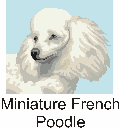
Miniature French Poodle
The Poodle or standard Poodle is a large dog that is one of the smartest of all dog breeds. Poodles have an elegant and well-proportioned body. The chest is deep and reaches to the elbows and the back is straight and fairly short. The belly is tucked up and the tail is usually docked to about one third of its length in countries that permit docking. The Poodle’s head is elongated with a straight nose and pendulous ears set even with the eyes. The Poodle’s coat can come in two types – curly or corded. The curly coat is by far the most prevalent and consists of abundant, springy and woolly curls that are profuse with firm texture. There is no under coat and colors can be any solid color. The corded coats are extremely rare and also consist of dense and woolly hair. Standard poodles stand 16 to 24 inches tall at shoulder height and weigh from 45 to 65 pounds. Miniature Poodles stand 11 to 15 inches at shoulder height and weigh about 15 pounds. Toy Poodles stand 10 inches tall or less at shoulder height and weigh up to 11 pounds.
Miniature and Toy Poodles are not as intelligent, easily trained or child-friendly as the Standard Poodle, which is one of the smartest and most trainable of all dog breeds. The standard Poodle is lively, good natured, friendly, proud, athletic, affectionate and extremely loyal. This is a thinking dog that can be trained very easily and almost anticipates any command. Poodles are very loyal and become very attached to their owner and family. Poodles that are socialized early do very well with children, other pets and strangers. Adolescent Poodles can be very exuberant and toddlers and small children should be supervised carefully to avoid any knock downs. Poodles will announce visitors with a bark and make good watchdogs.
The standard Poodle was originally a hunting dog used to retrieve ducks and therefore loves lots of exercise and swimming. During the first few years this breed should be allowed to run and play off leash as well as be taken for long daily walks. These dogs excel at any agility sport or competition and also are frequent winners at advanced obedience competitions.
The amount of grooming required for a Poodle depends completely on whether you plan to show the dog and which type of cut you want. Show dogs require extensive clipping and this is usually best left to a professional. Poodles that are kept as pets can be groomed in any manner you wish but are usually clipped fairly short to minimize grooming time. Poodles should be washed fairly frequently as their coats get greasy and should be trimmed every 6 weeks or so. Remember to check the teeth frequently for tartar build-up and hand pluck excessive hair growing inside the ears. If you don’t like spending time grooming your dog, you should probably avoid a Poodle. Poodles do not shed their hair and are often called ‘hypoallergenic’ because they are good for people with allergies.
Miniature Maltese Poodle
The Maltese is one of the most intelligent and most gentle of all the toy dog breeds. This lively and agile little toy dog loves to play games. Maltese are small in stature and usually stand 8 to 9 inches tall at shoulder height and weigh from 4 to 7 pounds. This toy dog breed has a long-haired coat without any undercoat. The gorgeous coat is straight and silky without any curls and is pure white in color.
This toy breed is cheerful, loving, playful, smart and has lots of personality. This intelligent toy dog adores and wants to please his master, so it is fairly easy to train. Maltese should have early socialisation while they are puppies to give them more confidence and overcome their distrust of strangers. Maltese enjoy obedience training and some will do well in competitive obedience and agility competitions. If you overindulge and spoil this toy dog, you will probably end up with an insecure, spoiled and barky dog. This toy breed tends to be barky and difficult to house train so early training will help both of those problems. Maltese love to go for walks but keep them on-leash to prevent them from being attacked by a larger dog. This toy breed does fine with older and considerate children but does not like the rough handling that can happen with toddlers. Maltese are somewhat cautious with strangers and make fine watchdogs.
This breed gets lots of exercise playing inside but does like to go on walks with its owner. Maltese are sensitive to inclement weather and would rather be a lap dog on cool or wet days. Remember to use a wide collar or a harness to avoid injury when taking them for a walk. Maltese make good apartment dogs.
Maltese require a lot of grooming including daily combing and brushing and regular bathing. The coat is parted down the centre of the back and should almost reach the ground. These dogs do not shed their hair and the dead hair should be brushed and plucked out. The hair in front of their eyes should be held up with a head band or bow to allow the Maltese to see.

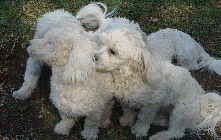
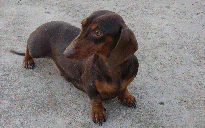
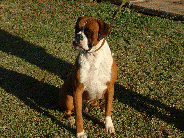
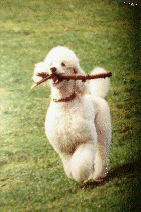


A well-bred Rottweiler is calm, intelligent, serious, loyal confident and courageous but has territorial instincts and can be aggressive in defence of its family. The Rottie is a very strong dog with a pronounced sense of duty to protect its owner and family from strangers and strange dogs. Therefore it is imperative that this breed be thoroughly socialized and obedience trained starting when it is a puppy and continuing through adolescence. Rotties remember what they learn and are fairly easy to train. This breed enjoys mental stimulation as well as exercise and makes a good obedience, agility and schutzhund competitor. Rotties are working dogs and are not happy unless being challenged both physically and mentally. Rottweilers are not suited for indoor life and enjoy being outside. Rotties do well with children and also other pets if they are raised with them. Because of unscrupulous breeders and breeders that trained Rottweilers as guard dogs, a fair amount of hysteria has developed around the breed. Some cities and towns have banned the breed and some insurance companies will not provide homeowners insurance. A well trained Rottie makes a great family pet but this breed is not for everyone. Only people who have the time to thoroughly socialize, obedience train, and keep this dog active should become Rottie owners. This dog must have an experienced and assertive dog owner who knows how to handle a strong willed dog.
The Rottweiler is an outdoor dog that needs lots of exercise and daily activities. Rotties enjoy mental challenges as well as physical activities, so get them involved in advanced obedience, agility or schutzhund training. See our article on “Fun Dog Activities” for information on these and other activities. After the Rottie is 12 to 18 months old you can give him lots of vigorous exercise by taking him jogging and biking. The Rottie is a medium shedder that is easy to maintain by brushing 2 or 3 times per week with a bristle brush and a hound glove. This breed only requires an occasional bath.
Dobermans are usually protective but also are sweet and docile family dogs. This breed is brave, intelligent and loyal. However some Dobermans are very nervous and aggressive. This breed needs early socialization and obedience training when it is a puppy and this regime should be continued until the dog is at least 18 months old. Dobermans do fine with older children if they are raised with them. Male Dobes can be very aggressive with other male dogs and shouldn’t be trusted with small pets and strange children. Dobermans need lots of exercise and companionship and shouldn’t be left alone for long periods of time. Dobermans are intelligent and easily trained but not by a novice dog owner. This breed should spend a significant amount of time at a dog training school. Dobermans make good guard dogs and good watchdogs and are wary of strangers. This breed is not recommended for the novice dog owner.
Doberman / Rottweiler










